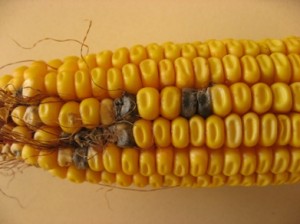 Source: A. Robertson, Iowa State University Plant Pathology. |
 Source: A. Robertson,Iowa State University Plant Pathology |
 Source: G. Munkvold, Iowa State University Plant Pathology. |
Symptoms:
This fungus appears gray to black or very dark green, and can have a powdery appearance. It also causes black streaks in the kernels. Not associated with mycotoxins.
Causes:
Cladosporium herbarum and other species often infect kernels damaged by insects, hail, or frost. This disease can be fairly common but usually does not cause extensive damage to the ear.
Management:
Plant a hybrid with ear rot resistance; avoid harvest delays and planting corn on corn , especially under conservation tillage, and reduce stress on the plants with adequate fertilization and good insect pest management.
References:
Lipps, P. E., A. E. Dorrance, and Dennis Mills. 2004. Corn Disease Management in Ohio Bulletin 802.
Robertson, A. 2004. Corn Ear Rots. Iowa State University IPM.IC-492(21) [October 4, 2004] Available at https://lib.dr.iastate.edu/cgi/viewcontent.cgi?referer=https://www.google.com/&httpsredir=1&article=2505&context=cropnews [URL verified 3/28/2019].
Robertson, A. and G. Munkvold. 2009. How Delayed Harvest Might Affect Ear Rots and Mycotoxin Contamination. Iowa State University Department of Plant Pathology. Available at http://www.extension.iastate.edu/CropNews/2009/1030robertsonmunkvold.htm [URL verified 3/28/2019].